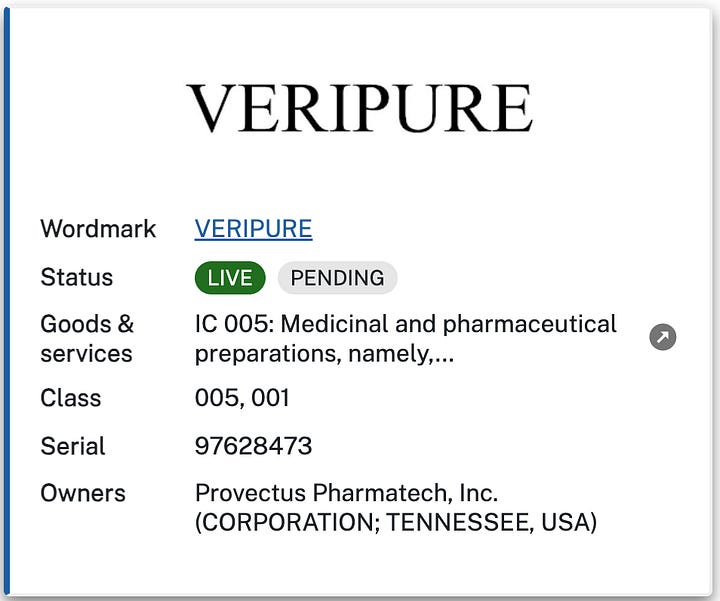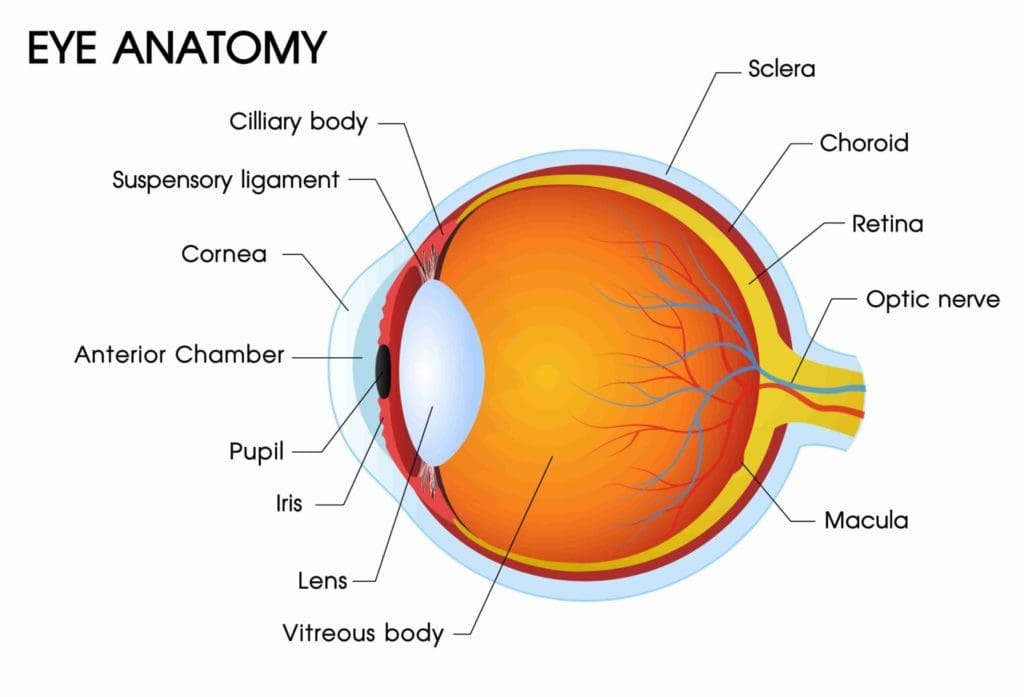Provectus News Day: October 7, 2024
4th quarter conference call • Veripure Trademark • Patents and Patent Applications in 2024 • EyeCo update • Ferrari race car driver and Provectus patient
Provectus Biopharmaceuticals, Inc. (OTCQB: PVCT) uses GlobeNewswire-distributed press releases, U.S. Securities and Exchange Commission (SEC) filings, and its website to disclose material financial and operational information to shareholders, prospective investors, the media, and those interested in the Company. Substack is a means of disclosing observations about Provectus and for complying with disclosure obligations under SEC Regulation FD.
Company Conference Call
We are finalizing the date for a fourth quarter conference call (CC). We previously said that we would have a CC in the third quarter, for which we apologize.
We expect Provectus’s next CC to have a Q&A session for Company stockholders and other stock market participants. We will press release date, time, and call-in details when available.
Intellectual Property: Veripure Trademark
Provectus’s application for a trademark of Veripure may now make headway because another applicant for the mark abandoned its application.


We plan to discuss our proposed strategy for and contemplated use of the Veripure trademark during the CC.
Intellectual Property: 2024 Patents & Published Patent Applications
Another of Provectus’s approximately 10 submitted patent applications (i.e., pending applications) was published on the website of the U.S. Patent and Trademark Office (USPTO), titled “ANTI-BACTERIAL EFFECT OF HALOGENATED FLUORESCEINS AGAINST COLISTIN-RESISTANT GRAM-NEGATIVE BACTERIA” (October 3; publication no. 2024/0325341).
This marks the fourth published patent year-to-date, along with four awarded patents in 2024.
Awards
Composition and method for oral treatment of leukemia (August 20; patent no. 12,064,507),
In vitro and xenograft anti-tumor activity of a halogenated-xanthene against refractory pediatric solid tumors (May 7; no. 11,974,980),
Uses of halogenated xanthenes in oncology and virology (May 7; no. 11,975,106), and
Halogenated xanthenes as vaccine adjuvants (March 26; no. 11,938,182).
Published applications
Halogenated Xanthenes as Vaccine Adjuvants (September 26; publication no. 2024/0316191),
Vitro and Xenograft Anti-Tumor Activity of a Halogenated-Xanthene Against Refractory Pediatric Solid Tumors (August 22; no. 2024/0277655), and
Composition and Method for Treating Hematologic Cancers (March 14; no. 2024/0082206).
Corporate Development: EyeCo
We plan to provide an update on the CC about Provectus’s efforts to spinout EyeCo (a placeholder name). We had hoped to launch it in the third quarter. Again, we apologize.
We may launch EyeCo in the fourth quarter: a clinical-stage biotechnology company of the University of Miami and Provectus focused on commercializing the Miller School of Medicine’s Bascom Palmer Eye Institute and its Ophthalmic Biophysics Center’s innovative ocular research using bioactive synthetic small molecule rose bengal (and Provectus’s pharmaceutical-grade active pharmaceutical ingredient [API] and drug substance rose bengal sodium [RBS]).
We have already developed a name, logo, brand, website, and corporate/investor slide deck for EyeCo.
American Academy of Ophthalmology
Two presentations/session at the 2024 annual meeting of the American Academy of Ophthalmology (AAO) in Chicago, IL on October 18-21 will address Bascom Palmer’s rose bengal (RB) photodynamic antimicrobial therapy (PDAT) (RB PDAT):
First, Salomon Merikansky, MD of Bascom Palmer will present “Rose Bengal Photodynamic Antimicrobial Therapy as Adjunct Therapy for Pseudomonas Necrotizing Scleritis.”
Bascom Palmer’s initial indication of infectious keratitis addresses infections of the cornea, where it has shown clinical evidence for RB PDAT. Its second indication, and the subject of the poster presentation, targets infections of the sclera, where Bascom Palmer will provide clinical evidence. The incidence of scleritis is approximately 19 per 100,0001, of which approximately 5 to 18% are infectious234.
See an illustration of the anatomy of the eye below.
The abstract of this presentation reads as:
Purpose To describe the utility of rose bengal photodynamic antimicrobial therapy (RB-PDAT) as an adjunct treatment in necrotizing scleritis secondary to Pseudomonas aeruginosa (PA). Methods Retrospective chart review was conducted on consecutive patients with scleritis and culture-proven PA who underwent RB-PDAT. Results Six patients with PA necrotizing scleritis were included. All patients achieved complete resolution of the infection. The mean time to resolution after RB-PDAT was 24.8 days (range: 6-30 days), with a total treatment course average of 89.2 days (range: 30-226 days). One patient with pan-resistant PA sclerokeratitis required two RB-PDAT treatments due to persistent stromal melting. None of the patients required enucleation. All patients received a standardized regimen of oral fourth-generation fluoroquinolone, topical tobramycin and ciprofloxacin. The patient with pan-resistant PA required treatment with topical imipenem. Conclusion RB-PDAT is a feasible option to halt the progression of infectious necrotizing scleritis caused by Pseudomonas, especially in cases of impending perforation.
Second, Bhupesh Bagga, DO, MBBS of LV Prasad Eye Institute in India will discuss “Acanthamoeba Keratitis: Strategic Management.” The abstract of this session reads as:
Synopsis Acanthamoeba keratitis is one of the most challenging corneal infections. Its management, which is always controversial, comprises both medical and surgical treatments. The challenges range from making an early diagnosis to starting appropriate treatment. In this course we will explain a scientific and strategic approach to managing these infections, and we will also explore newer and future methods for controlling and eradicating them. This course will introduce all attendees to a basic, simplified and strategic approach to Acanthamoeba keratitis management. Newer ways of treatment, like rose bengal photodynamic antimicrobial therapy (RB-PDAT) and corneal crosslinking with photoactivated riboflavin (PACK-CXL), will also be presented. Objective This course aims to develop and explain the strategic management of Acanthamoeba keratitis.
Former PV-10 Patient Brad (“Tex”) Evans Update
Dr. Evans continues to race in one of the Ferrari Challenges in 2024, and is currently in fifth place. You can read his statistics here, and see the points standings below.

We wrote about Tex (Dr. Evans) in the April 6, 2024 Substack titled “Stage IV Melanoma: ‘…the company that saved my life.’”
Conversion of Provectus’s Board of Directors’ Fees into Company Equity
In an August 19, 2024 Form 8-K filing, the Company noted that more than $2.1 million of accrued but unpaid directors’ fees were converted into Provectus equity:
“On August 14, 2024, the Board of Directors (the “Board”) of Provectus Biopharmaceuticals, Inc. (the “Company”) approved the conversion of accrued but unpaid directors’ fees of current and former Board members owed through September 30, 2024 (“Accrued Fees”) into the Company’s Series D-1 Preferred Stock (“Preferred Stock”) at a price per share equal to $2.862 and the issuance of this Preferred Stock to current and former Board members. The Preferred Stock is being issued to satisfy payment of outstanding cash fees owed to the Company’s directors and is not being issued as a separate award under the Company’s 2024 Equity Compensation Plan. The total amount of Accrued Fees through September 30, 2024 will be $2,131,838.75, which would convert into 744,878 shares of Preferred Stock, which would convert into 7,448,780 shares of Common Stock.
On April 12, 2017, the Board approved the accrual of directors’ fees until such time as the Board authorized the payment of director compensation, as reported on the Company’s Form 8-K filed on April 18, 2017.”
Forward-Looking Statements
The information provided in this Provectus Substack Post may include forward-looking statements, within the meaning of the Private Securities Litigation Reform Act of 1995, relating to the business of Provectus and its affiliates, which are based on currently available information and current assumptions, expectations, and projections about future events and are subject to a variety of risks and uncertainties and other factors that could cause actual events or results to differ materially from those projected in the forward-looking statements. Such statements are made in reliance on the safe harbor provisions of Section 27A of the Securities Act of 1933 and Section 21E of the Securities Exchange Act of 1934. Forward-looking statements are often, but not always, identified by the use of words such as “aim,” “likely,” “outlook,” “seek,” “anticipate,” “budget,” “plan,” “continue,” “estimate,” “expect,” “forecast,” “may,” “will,” “would,” “project,” “projection,” “predict,” “potential,” “targeting,” “intend,” “can,” “could,” “might,” “should,” “believe,” and similar words suggesting future outcomes or statements regarding an outlook.
The safety and efficacy of Provectus’s drug agents and/or their uses under investigation have not been established. There is no guarantee that the agents will receive health authority approval or become commercially available in any country for the uses being investigated or that such agents as products will achieve any revenue levels.
Due to the risks, uncertainties, and assumptions inherent in forward-looking statements, readers should not place undue reliance on these forward-looking statements. The forward-looking statements contained in this Provectus Substack Post are made as of the date hereof or as of the date specifically specified herein, and the Company undertakes no obligation to update or revise any forward-looking statements, whether because of new information, future events, or otherwise, except in accordance with applicable securities laws. The forward-looking statements are expressly qualified by this cautionary statement.
Risks, uncertainties, and assumptions include those discussed in the Company’s filings with the U.S. Securities and Exchange Commission, including those described in Item 1A of Provectus’ Annual Report on Form 10-K for the period ended December 31, 2023 and on Form 10-Q for the period ended June 30, 2024.
Zhang Y, Amin S, Lung KI, Seabury S, Rao N, Toy BC. Incidence, prevalence, and risk factors of infectious uveitis and scleritis in the United States: A claims-based analysis. PLoS One. 2020 Aug 25;15(8):e0237995. doi: 10.1371/journal.pone.0237995. PMID: 32841267; PMCID: PMC7447056.
Ho YF, Yeh LK, Tan HY, Chen HC, Chen YF, Lin HC, Chen SY, Hui-Kang D, Hsiao CH. Infectious scleritis in Taiwan-a 10-year review in a tertiary-care hospital. Cornea. 2014 Aug;33(8):838-43. doi: 10.1097/ICO.0000000000000174. PMID: 24977990.
Ramenaden ER, Raiji VR. Clinical characteristics and visual outcomes in infectious scleritis: a review. Clin Ophthalmol. 2013;7:2113-22. doi: 10.2147/OPTH.S37809. Epub 2013 Nov 4. PMID: 24235809; PMCID: PMC3821753.
Reddy JC, Murthy SI, Reddy AK, Garg P. Risk factors and clinical outcomes of bacterial and fungal scleritis at a tertiary eye care hospital. Middle East Afr J Ophthalmol. 2015 Apr-Jun;22(2):203-11. doi: 10.4103/0974-9233.150634. PMID: 25949079; PMCID: PMC4411618.





